Winter is a great time to daydream about future gardens – the garden that could be, the garden of your dreams. Soon it'll be time to prune the roses. The fruit trees are there just waiting for dormant spray and a little winter pruning and those tangled vines beckon you every time you walk by. But for now why not let your imagination go wild and consider adding a green wall to enjoy while you sit on the patio this summer?
While I was up in the Pacific Northwest over Christmas time I had the opportunity to visit two impressive green walls. Also called living walls they got me thinking about the wall behind the patio table on my deck. It would look just awesome covered with living plants. Much of the cost of a large green wall installation is the irrigation system which allows for easy maintenance but since I'm willing to water it by hand every few days my wall will be an affordable version. First though, some inspiration.
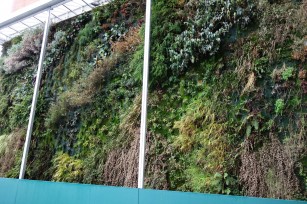 The first wall I visited was the 20-by-40-foot living wall at the Goodwill-Milgard Work Opportunity Center in Tacoma. Designed by the the famous French inventor of modern green walls, Patrick Blanc, this wall literally dripped with plants, moss and raindrops on the day I was there.
The first wall I visited was the 20-by-40-foot living wall at the Goodwill-Milgard Work Opportunity Center in Tacoma. Designed by the the famous French inventor of modern green walls, Patrick Blanc, this wall literally dripped with plants, moss and raindrops on the day I was there.
Installed in 2009 the diagonal swaths of plants are inserted between a double layer of felt, slit to make planting pockets. Most of the soil was knocked off small 4" plants, even the woody plants. I read that Blanc used 96 different species initially but only the toughest have survived. Granted it was December when I saw the wall and some of the plants were dormant but those remaining were quite colorful and made a beautiful tapestry. Stripes of golden acorus grew beside ribbons of bergenia, artemisia, euphorbia, rubus, carex grass, Asiatic jasmine, thyme, pachysandra and vinca minor. Bands of variegated iris high up on the wall caught my eye and I marveled at the woody lily-of-the-valley shrubs and skimmia that remained small in this environment.
A drip irrigation runs across the top of the wall and in a horizontal band halfway down. Water and fertilizer drip through the felt to keep the plants perpetually moist and nourished similar to the mossy cliffs where many of these plants grow in their native environments. There's a freeze switch to stop the irrigation on the coldest days so the wall doesn't turn into a solid wall of ice. I was told that the wall is pruned twice a year via a cherry picker.
The plan for my own living wall is to mimic the look with those Woolly Pocket planters 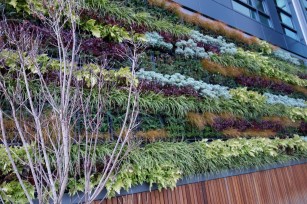 made from recycled plastic bottles. They're the simplest and lightest to use. For clients I can suggest an outdoor wall near the kitchen planted with rosemary, oregano, thyme, parsley and other sun-loving herbs. Or in a super shady spot, the pockets could be planted with hardy houseplants like spider plant, creeping jenny, queen's tears, small ferns, wandering jew and creeping charlie. These have all survive at my house under the overhang for more years than I can count.
made from recycled plastic bottles. They're the simplest and lightest to use. For clients I can suggest an outdoor wall near the kitchen planted with rosemary, oregano, thyme, parsley and other sun-loving herbs. Or in a super shady spot, the pockets could be planted with hardy houseplants like spider plant, creeping jenny, queen's tears, small ferns, wandering jew and creeping charlie. These have all survive at my house under the overhang for more years than I can count.
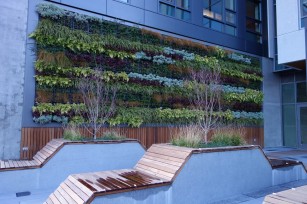 The second living wall I visited in Seattle covered a new building outside the new Amazon offices. This green wall is constructed from a vertical metal grid that supports square modular trays. The plants grow lush in soil pockets with micro spray irrigation providing moisture and nutrients. The effect is beautiful to look at and experience.
The second living wall I visited in Seattle covered a new building outside the new Amazon offices. This green wall is constructed from a vertical metal grid that supports square modular trays. The plants grow lush in soil pockets with micro spray irrigation providing moisture and nutrients. The effect is beautiful to look at and experience.
Winter chill made the plants pop with bright colors and glowed with deep gold, burgundy red, acid green and tawny auburn. Diagonal bands of familiar hardy plants such as carex buchanii, cotoneaster lowfast, iberis, star jasmine, Powis Castle artemisia, liriope and ferns drew my eye up, down and sideways. The wall encloses a small plaza with warm wood and concrete seating which would be inviting to sit and stay awhile on a warm day.
I'm looking forward to putting together my own green wall. I may even grow succulents in a frame in another spot. It's an easy fun project to enhance your time outdoors and I plan to suggest this design solution whenever possible in the future. Take the time to day dream about something new and fun for your own garden.

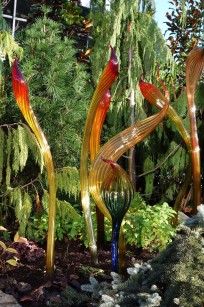
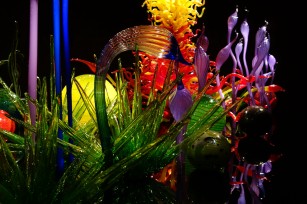
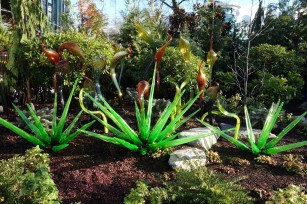
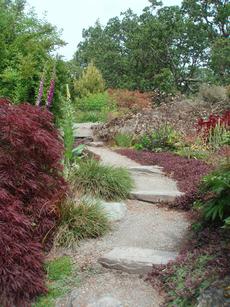
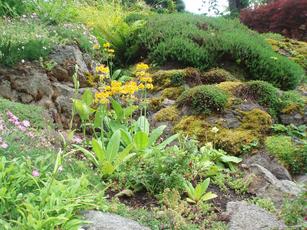
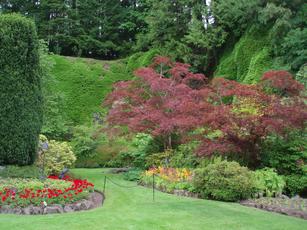
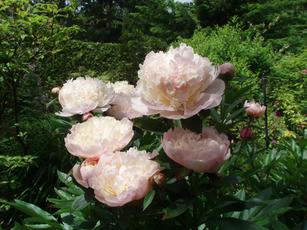
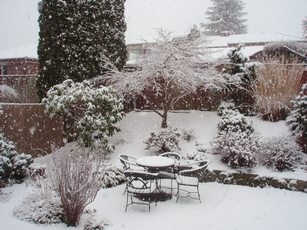 tly through the snow. Ornamental grasses, not yet cut back, made me think of the prairie in winter. Japanese maples of every type showed off their exquisite form cloaked with a few inches of snow. Everywhere tall evergreen trees as well as dwarf forms anchored the landscape especially in winter.
tly through the snow. Ornamental grasses, not yet cut back, made me think of the prairie in winter. Japanese maples of every type showed off their exquisite form cloaked with a few inches of snow. Everywhere tall evergreen trees as well as dwarf forms anchored the landscape especially in winter.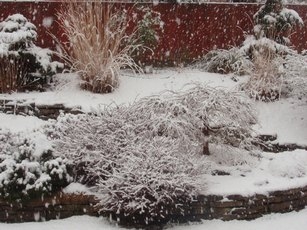 Water conservation is important here, too. Although this area receives lots of winter rain and snow in the mountains by summer’s end, rivers and reservoirs in the Cascades, ground water levels and collected snowmelt reserves are gone. A little rain falls in the summer but it’s still a Mediterranean climate here. Water needs of people compete with those of migrating salmon and other wildlife and vegetation. Climatologists are predicting that climate change may mean less snow pack in the future.
Water conservation is important here, too. Although this area receives lots of winter rain and snow in the mountains by summer’s end, rivers and reservoirs in the Cascades, ground water levels and collected snowmelt reserves are gone. A little rain falls in the summer but it’s still a Mediterranean climate here. Water needs of people compete with those of migrating salmon and other wildlife and vegetation. Climatologists are predicting that climate change may mean less snow pack in the future.